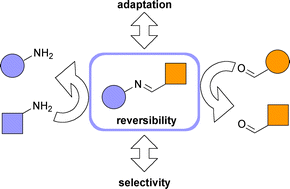In analogy to evolution in biological processes, “molecular evolution”, based on the reversible formation of imines, has successfully been explored for drug discovery, receptor design and as a controlled-release vehicle. Multicomponent systems composed of amines and carbonyl compounds generate structural diversity by reversible reaction of the different components to form equilibrated dynamic mixtures or combinatorial libraries (DCLs). Under thermodynamic control and in the presence of an external factor which influences the equilibrium, these systems evolve by selective adaptation to the changing external conditions. This concept allows the casting of biologically or catalytically active substrates and the molding of receptors from DCLs which are composed of smaller non-active amine and carbonyl moieties. Similarly, if the amine or carbonyl compounds are the biologically active compounds of interest, the corresponding dynamic mixtures are found to be efficient delivery systems, allowing their controlled release over time.

You have access to this article
 Please wait while we load your content...
Something went wrong. Try again?
Please wait while we load your content...
Something went wrong. Try again?


 Please wait while we load your content...
Please wait while we load your content...